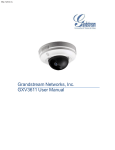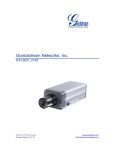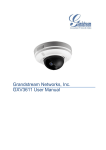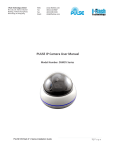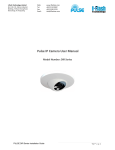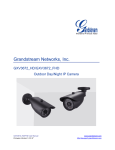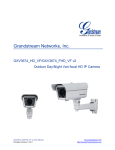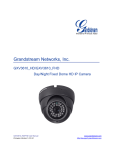Download IP camera User Manual
Transcript
IP camera User Manual Safety Instructions These instructions are intended to assist users with the operation of the IP camera and also to instruct on how to avoid dangerous situations or damage to the device. Warnings: Serious injury or death may be caused if any of the warnings below are neglected. Cautions: Injury or damage to the equipment may occur if any of the following caution messages are neglected. Warnings Follow these safeguards to prevent serious injury or death. Cautions Follow these precautions to prevent potential injury or material damage. Warnings: Input voltage should meet both the SELV (Safety Extra Low Voltage) and the Limited Power Source with DC 12V according to the IEC60950-1 standard. Please refer to the technical specifications for more details. Do not use a third-party power adapter or power cord When the device is installed on the wall or ceiling, make sure that it is firmly attached. Notice: Make sure that the power supply voltage is correct before using the camera. Do not drop the device or expose it to physical shock. Do not expose the device to temperatures outside the range of -10 oC to +60oC when the device is in operation. Do not expose the device to damp/wet conditions or high electromagnetism radiation. To avoid heat accumulation, make sure that your operating environment has proper ventilation. Do not attempt to open, disassemble, or modify the device A few parts (e.g. electrolytic capacitor) of the equipment shall be replaced regularly according to their average life time. The average life time varies from the differences between operating environments and usage history. Regular maintenance checks are recommended for all users. Please contact your dealer for more details. Contents Welcome .....................................................................................................................................................4 Minimum Recommended System Requirement ................................................................................5 Connect your IP camera ......................................................................................................................5 Configuring the IP camera via Web Browser ..............................................................................................6 Connect to the Camera using Static IP. ..............................................................................................6 IP camera Home Web Page .................................................................................................................7 IP camera System Page .......................................................................................................................8 IP camera Video & Audio Page...........................................................................................................9 IP camera Networking Page – Assign an IP to IP camera ...................................................................11 IP camera Wifi Page – IP camera supports WIFI via wireless dongles. ..............................................12 IP camera DDNS Page ........................................................................................................................12 IP camera SIP Page .............................................................................................................................13 IP camera Status Page .........................................................................................................................15 IP camera User Management Page......................................................................................................16 IP camera Maintenance Page ..............................................................................................................16 IP camera SMTP Page .........................................................................................................................17 IP camera FTP Page ............................................................................................................................18 IP camera Motion Detection................................................................................................................18 IP camera System Log..........................................................................................................................21 Welcome The IP camera is a next generation IP camera for remote monitoring and surveillance over your LAN or internet. The IP camera combines best in class IP video technology and SIP protocols for a robust IP surveillance solution. The product features H.264 video streams with up to 30 frames per second in full D1, delivering rich image clarity at rapid transmission rates. Integrated SIP can pass alarms to the PSTN, mobile phones, SIP IP phones, SIP videophones and enables 2-way VoIP communication. The IP camera ensures ease of use, integration and deployment with a multilingual graphical user interface. The IP camera can be quickly installed and connected to your network and accessed from anywhere over the internet. flexible video management software enables users to monitor multiple environments in one easy to use application. The intuitive web interface lets users easily access, manage, view and record live video streams from the device. The IP camera is a powerful solution for small to medium sized offices, homes and storage facilities looking to safeguard their valuables. Installation Guide Minimum Recommended System Requirement • Windows 2000 Server Professional, Windows XP, Windows Vista. • • • CPU: Intel Pentium 4 or higher, 2 GHz. RAM: 1 GB (4 GB recommended for larger systems). Support for DirectX 8.0 and above. . Connect your IP camera Using the Power adapter as power supply • • • NOTE: Connect an RJ-45 cable to the NETWORK port of the IP camera. Connect the other end of the RJ-45 cable to your network or PC. Connect the power supply to the DC 12V power jack on the back of the IP camera. If you are going to connect the device to a hub/switch/router, please use a straight-through cable. A cross over cable should be used if you are going to connect the device directly to a PC. Configuring the IP camera via Web Browser The IP camera‟s embedded Web server responds to HTTP/HTTPS GET/POST requests. Embedded HTML pages allow you to configure your IP camera through Microsoft Internet Explorer. Connect to the Camera using Static IP. If the camera does not get response from DHCP server after 3 minutes, it can be accessed by the default IP 192.168.1.168. 1. Connect your PC to the same network as the IP camera. 2. Configure the IP address of your PC to: 192.168.1.XXX (1<XXX<255) and configure the subnet mask to 255.255.255.0. 3. 4. 5. 6. Make sure that the device is turned on and connected to the network. Start Internet Explorer on your computer. Enter 192.168.1.168 in the address bar of the browser. Enter the administrator user name and password to access the Web Configuration Interface 7. The default user name and password are both set to admin. 8. IE will indicate that “This website wants to install the following add-on: Install this add-on by following the instructions in IE. 9. You will see the home page. IP camera Home Web Page Figure2: Home web page of IP camera-N and IP camera-LL Figure3: Home web page of IP camera-HD Items on IP camera Home Page 1 Motion Detection If the motion detection alarm is triggered, the indicator will flash red. Click on the indicator to turn off the alarm. 2 Alarm Event If an alarm event is triggered, the indicator will flash red. Click on the indicator to turn off the alarm. 3 4 5 6 Control Console ZOOM FOCUS Default PTZ Console controller. PTZ device needs to be connected. NOTE: IP camera does not support zoom Adjusts the focus of images. Click this option to reset the video brightness, contrast, and saturation to their factory default configuration. 7 SPEED Adjusts the rotation speed of the console. 8 9 BRIGHTNESS CONTRAST Adjusts the image brightness. Adjusts the image contrast. 10 11 SATURATION View Size Adjusts the image saturation. Resize the image to fit into the window panel in the home scream. 12 13 Play Capture Plays/Stops the video. Captures the image displayed and saves it to C:\GS_Capture 14 Record 15 16 Sound Off/On Talk (default directory). Records the video and saves it to C:\GS_Record (default directory). Toggles the sound On or Off. Establishes two-way audio. 17 Playback Replays the saved video. 18 Config Configures the Save Location for captured images and recorded videos. IP camera System Page This page allows you to configure the system settings on IP camera. Current System Time - displays the current date and time (24h clock). Set the System Time Update via NTP Server - the camera will obtain the time from an NTP server Specify the NTP server's IP address or Page 16 of 36 host name. And you can select your time zone from the drop-down list or define your own time zone setting. NOTE: If using a host name for the NTP server, a DNS server must be configured under Basic Settings -> Networking. Synchronize with Local Computer - sets the time from the clock on your computer. Set the Time Manually - this option allows you to manually set the time and date. OSD Date Format - set the format of date on OSD Device Name Setting -This field lets you configure the name of the IP camera, which helps GSurf and GS_NVR to indentify the device when using GS_Search to search all network cameras or digit video cameras in the same subnet. DI and DO - Digital input and digital output Normal open: the circuit is by default open unless an event triggers the device to close the circuit. Normal close: the circuit is by default closed unless and event triggers the device to open the circuit IP camera Video & Audio Page On Screen Display (OSD) Settings OSD Time/ Text – The time stamp and channel name displayed on the screen. Video Settings Preferred Video Codec – The IP camera supports the H.264 video codec. Resolution – The higher the resolution is, the better the video quality is, and higher bandwidth is required. Low -----------------------Æ High Resolution 480x272, 800x480, 1280x720,1280x960,1920x1080 Bit Rate – The number of bits that are conveyed or processed per unit of time. Maximum Frame Rate – The video frame rate is adjustable based on network conditions. Increasing the frame rate will increase the amount of data significantly therefore consuming more bandwidth. Video will be impaired due to packet loss when there is insufficient bandwidth. Bit Rate Control – Variable Bit rate (VBR) and Constant Bit Rate (CBR). Variable Bit Rate - If VBR is selected, the codec varies the amount of output data per time segment. VBR produces a better quality-to-space ratio. The bits available are used to enable more flexibly and encode sound or video data more accurately, with fewer bits used in less demanding passages and more bits used in difficult-to-encode passages. Constant Bit Rate - If CBR is selected, the codec‟s output data is constant regardless of the input data. The output bit rate is defined in “Bit rate”. CBR is useful for streaming multimedia content on limited capacity channels. It is easier to calculate required bandwidth as well as the required storage space using CBR. Image Quality – If „Bit Rate Control‟ is set to “VBR”, “Image quality” needs to be configured. The better the video quality is, the higher the bit rate will be. I-frame Interval – While streaming video over a network, compression technologies are used to show the incremental difference between each frame. I-frames are used to help keep the video looking normal. When intervals are shorter, the video quality is higher but uses more bandwidth. NOTE: The users might need to configure the Primary Stream and Secondary Stream properly. Sometimes, the user might like to watch the live video stream from the web GUI in low resolution mode while recording a copy via GSurf/GS_NVR in high resolution due to the limitation of internet bandwidth. In this case, for example, primary stream can be configured to have better resolution, and then the users can use primary stream to record while watching secondary video streams. Audio Settings Preferred Audio Codec – The IP camera supports up to 3 different Vocoder types, a-law (PCMA), u-law (PCMU) and G.726. The audio can also be turned off by switching the setting to “Disabled” Audio Compression – Audio Page 18 of 36 compression is a form of data compression designed to reduce the size of audio files. Usually, the higher the audio compression is, the better the audio quality is. Power Frequency - this setting should match the power frequency used in the country to avoid flickering in the image. And it is only available for IP camera IP camera Networking Page – Assign an IP to IP camera IP camera supports IP version 4. The IP address can set automatically via DHCP, or a static IP address can be set manually. To make IP camera work properly, the user needs to set the DNS configuration properly. For security purposes, the user can also assign the IP camera an HTTP Port other than 80. IP Address Configuration The IP camera operates in two modes: Dynamically Assigned via DHCP – all the field values for the Static IP mode are not used. The IP camera acquires its IP address from the first DHCP server it discovers on its LAN. Statically Configured as – configures all of the following fields: IP address, Subnet Mask, Default Gateway IP address, DNS Server 1 (primary), DNS Server 2 (secondary). These fields are set to zero by default. Static IP addresses are recommended for the IP camera DNS Configuration There are two methods of DNS configuration on the IP camera: 1. The IP camera can obtain the DNS server automatically 2. Users can configure their own preferred DNS server HTTP Port The IP camera supports user configured http ports. If the HTTP port is changed, the port number is needed to access the web GUI, for instance: http://192.168.1.168:8080. NOTE: If the HTTP Port is 80, when you add this device to GSurf or GS_NVR, the RTSP port is 554. If the HTTP Port is changed, when you add this device to GSurf or GS_NVR, please make sure the RTSP port number equals HTTP Port plus 2000. IP camera Wifi Page – IP camera supports WIFI via wireless dongles. Enable Wifi – Checked to enable Wifi SSID – Click on Scan to view available network. Choose a network and Click on Select to confirm. Security Mode – Choose associated Security mode. IP camera DDNS Page Dynamic DNS provides devices that have a variable, often changing IP address with a well known hostname resolvable by network applications through standard DNS queries. Set up DDNS 1. Apply for a domain name from your service provider. 2. Login to the web configuration page, click Basic Settings > DDNS. 3. Enter the required information DDNS Active – If you want to use DDNS, please set this field to “Enabled” . DDNS ISP Type – Select your DDNS ISP Type. Self-Define DDNS Address – Self-define the DDNS server instead of using DDNS ISP Type. Site Name – The DDNS name for your device. DDNS Account/ DDNS Password – The account and password from the DDNS Provider. STUN Server – If the device is behind a router, a STUN server is needed to help penetrate the NAT. 4. Click Save to save the changes. You might need to reboot the device to apply all the changes. IP camera SIP Page The IP camera has the ability to receive phone calls and make phone calls when an alarm event is triggered through motion detection or alarm input. Register the IP camera to a SIP server to enable the product to make and receive phone calls. To make outgoing phone calls out, the user needs to configure the Phone List properly. Register IP camera to a SIP Server 1. 2. 3. From the IP camera home page, click Basic Settings > SIP. Go to SIP Settings Tab. General Phone Settings. Registered – The field shows the registration status of the account with the SIP server. 4. Unregister On Reboot – If it‟s checked, the SIP user‟s registration information will be cleared from the server when the phone reboots. Enter the required information. Account Name – The field configures the SIP account name. SIP Server – The SIP Server‟s IP address or Domain name provided by your service provider. Outbound Proxy – The IP address or Domain name of the Outbound Proxy, Media Gateway, or Session Border Controller. Used for firewall or NAT penetration in different network environments. If the system detects a symmetric NAT, STUN will not work. ONLY outbound proxies can provide a solution for a symmetric NAT. SIP User ID – User account information provided by your service provider (ITSP); this is either an actual phone number or is formatted like one. Authenticate ID – The SIP service subscriber‟s Authenticate ID used for authentication. It can be identical to or different from the SIP User ID. Authenticate Password – The SIP service subscriber‟s account password for the GXV to register to the SIP server of the ITSP. STUN Server – If the device is behind a router, a STUN server is needed to help penetrate the NAT. Stream – To choose between Primary and Secondary stream. Preferred Vocoder – To choose different Vocoder type. Registration Expiration – This parameter allows users to specify the time frequency (in minutes) in which the GXV refreshes its registration with the specified registrar. The default interval is 60 minutes. Local SIP Port – This parameter defines the local SIP port used to listen and transmit. The default value is 5060. 5. Local RTP Port – This parameter defines the local RTP-RTCP port pair that is used to listen and transmit. The default value is 5004. Click Save to save all the changes. You need to restart the device to apply all changes. SIP Open Door Settings Enable SIP open door – This will close the DO connections in the back to close the circuit connected to it. Key to open the door – DTMF key to close the circuit. Digits 0-9 only. Delay lock time (seconds) – This is the time in seconds that the circuit will remain closed when this function is triggered Configure Phone List Page To make sure the IP camera can make phone calls to the number you preferred when alarm is triggered. You need to add number to the phone list. Steps to add phone number: 1. From the IP camera home page, click Basic Settings > SIP. 2. Go to Phone List Tab. 3. Enter the Phone number and name, click Add a Number to save all the changes. 4. Numbers added to the system will be listed in this page. Available phone numbers NOTE: With current firmware, only the first phone number in the list will be called when an alarm is triggered. IP camera Status Page System Statistics System Statistics lists hardware and software information, for example, the part number, the software version, about the IP camera. Hardware Version – This field contains the product‟s hardware information. Part Number – This field contains the product part number information. Bootloader Version – Bootloader code version number. Core Version – Core code version number. Base Version – Base code version number. Firmware Version – Firmware code version number. System Up Time Since – This field shows the system up time since the last reboot. Network Status MAC Address – The device ID, in HEXADECIMAL format. LAN IP Address – This field shows the LAN IP address of the IP camera. LAN Subnet Mask – This field shows the LAN subnet mask of the IP camera. LAN Default Gateway – This field shows the LAN default gateway of the IP camera. DDNS Status – This field shows the status of DDNS. Camera Type This section shows the Lens information of IP camera. The Lens type information contains the brand name, the size of image sensor, the resolution and so on. IP camera User Management Page All current users will be list in the User List section of this page. You can also add and remove users here. Existing User Name –The field lists all of the current users. You can insert or remove users from the list by click on the Add or Update or Delete button. User Name / Password – The user name and password required to login. Privilege – The privilege for the user to access to configuration page. Allow Anonymous Login – If „Allow Anonymous Login‟ is set to Yes, no user name and password are required to login to the IP camera web configuration pages. If you login anonymously, you will not be able to change any settings. IP camera Maintenance Page Server Maintenance Restart – Click this button to restart the IP camera. Restore – Click this button to perform a partial factory reset (The IP address will not be cleared) . Firmware Upgrade and Provisioning Items Upgrade via – This field lets you choose the firmware upgrade method. The IP camera supports HTTP, HTTPS and TFTP. Firmware Server Path – The IP address or domain name of the firmware server (the location of the firmware files) . Automatic Upgrade Interval – Enter the frequency (in minutes) in which the HTTP/HTTPS/TFTP server will be checked for new firmware upgrades or configuration changes. Automatic Upgrade – The default setting is “No.” Choose “Yes” to enable automatic. HTTP/HTTPS/TFTP upgrade and provisioning. When set to “No”, the IP Camera will only perform a HTTP/HTTPS/TFTP upgrade and perform a configuration check once during the boot process. Performing a firmware upgrade: 1. Unzip the firmware package and copy the files to the firmware upgrade server directory. Upgrades are supported via TFTP, HTTP and HTTPS. 2. Log in to the Maintenance page of the IP camera. Select the server type from the dropdown list under the “Upgrade Via” field. Enter your server‟s root directory in the “Firmware Server Path” field. 3. Reboot the IP camera to begin the firmware upgrade process. IP camera SMTP Page The SMTP server is used to send out emails when an alarm event or motion detection is triggered. properly. The SMTP settings must be configured to make sure the alarm email is sent out SMTP Server Settings Enable SMTP – Checked to enable SMTP SMTP Server – The IP or hostname of the SMTP server, for example, smtp.gmail.com. SMTP Server Port – The port of the SMTP server. The IP camera supports port 25 and SSL port 465, which is for SMTP with an encrypted connection. From EMail Address – The email address that sends out the alarm email(s). To E-Mail Address – The email addresses that the alarm email(s) will be sent to. You can have up to 3 emails configured. User Name/ Password – The user name and password required to log in to your SMTP server, for example, [email protected]/123. SSL – Checked if the SMTP server requires a secure connection. Test Email Account Settings – Click the Test button to send a test email from the From E-Mail to the To E-Mail to make sure that SMTP is configured properly. If the receiver can get the test email, then the SMTP settings are ready to go. IP camera FTP Page The FTP server is used to store video files if you configure the IP camera to record video and upload it to the FTP server when an alarm event or motion detection is triggered. FTP Settings Enable FTP – The default setting is “No,” if you want the IP camera to upload the recorded video to the FTP server when an alarm is triggered, set this field to “Yes.” FTP Server – The IP address or hostname of the SMTP server, ie. ftp.myserver.com. FTP Server Port – The port that your FTP server is using. User Name / Password – The user name and password required to log into your FTP server Path – The directory in the FTP server where recorded video will be uploaded. Test FTP Account Settings – Click the Test button to upload a sample file to make sure that FTP is properly configured. IP camera Motion Detection Page The IP camera supports Motion Detection. To utilize this feature, please follow the below steps: 1. Setup the motion detection monitored area. 2. Configure the motion detection time schedule. 3. Configure alarm action properly. Setup Motion Detection Monitored Area Enable Motion Detection – If this option is selected, motion detection will be enabled. If something/somebody moves in the motion detection region, an alarm will be triggered. Show Motion Detection Regions – If this option is selected, the motion detection regions will be displayed on the screen with a white border. The white border for Motion Detection Regions NOTE: If Upload to Alarm center is checked for Alarm Actions, the white border will flash red when a motion detection alarm is triggered To Edit a Monitored Area 1. In the Select a Region dropdown list, select the region ID. 2. Click Edit. 3. Click on the video, drag and draw you preferred area. 4. Set the Sensitivity. Click the Save button to save the sensitivity. NOTE: The Sensitivity value varies from 0 to 100. The larger the value is, the higher the sensitivity. 5. Click Save to save the settings. Button to save sensitivity only To Remove a Monitored Area 1. In the Select a Region dropdown list, select the region you would like to remove. 2. Click Remove. 3. Click Save to save the changes. Configure Motion Detection & Alarm Actions An alarm action is what the IP camera is going to do when an alarm is triggered during the defined time period – the time schedule. The IP camera allows multiple alarm actions. Configure Motion Detection Time Schedule This section allows you to configure the time during which the IP camera will monitor the motion detection. The IP camera not only can monitor your settings but also can take actions when the alarm is triggered. Monitored region Dropdown list for date Available schedules time IP camera System Log This page is used to set up the system log server path and system log level. Once they are correctly configured, the device will send out system log messages to the system log server, which will help perform troubleshooting. Syslog Server – The IP address or URL of System log server. Syslog Level – Select the device to report the log level. Default is None. The level is one of Debug, Info, Warning or Error.





















